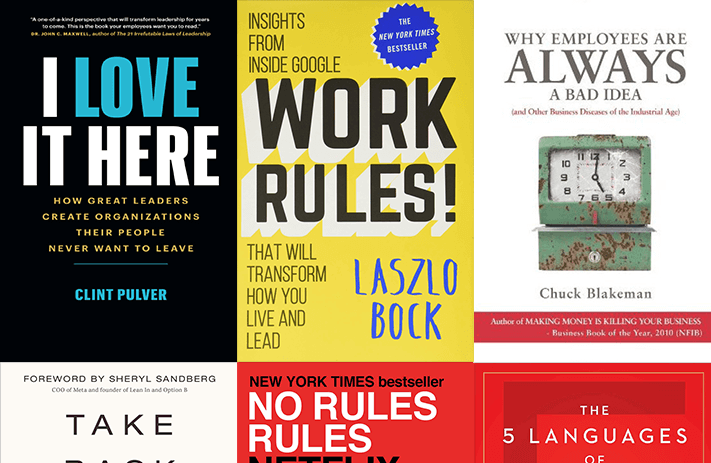
Click the button to start reading
Want to Build a Company You Crave? Here Are the Best Books on Workplace Culture
Way back in the 90s, political analyst James Carville liked to throw around the phrase, “It’s the economy, stupid.” It so encapsulated the political climate, he believed, that he made it a cornerstone of Bill Clinton’s presidential platform.
Anyone who’s earned his or her stripes rallying a team to align around a mission or a goal might well spin the phrase to say: “It’s the culture, stupid.” Or, veering away from Carville’s bluntness and quoting former IBM CEO Louis Gerstner, one might say: “Culture isn’t just one aspect of the game. It is the game.”
It would seem that a company of talented employees who all receive state-of-the-art equipment, ample vacation time and a fair wage is headed for success. But if the culture is one where employees thrive on malicious gossip, hard work goes unappreciated, and managers impose policies galore, the company is really like a train headed for a concrete wall.
Yet, culture is elusive. Just what is it, exactly? It’s as implicit as the air we breathe around the office and almost as difficult to grasp or perceive.
Culture is all those unwritten rules that make a workplace what it is. It’s reflected in how an office is set up, who runs meetings and what is discussed at them, who gets promoted and what sort of behavior gets recognized.

Ed Shein of the MIT school of management says a culture is most superficially reflected in the physical space (the layout of the office, the building, the artwork in the bathroom, the break and meeting rooms). More fundamentally, it’s revealed by the common beliefs of those in the organization and the assumptions behind those beliefs.
These beliefs and assumptions affect everything about a company. It impacts what people wear to work and how they interact with one another. A work culture that believes in collaboration enables a company to share ideas and develop new products. A work culture that believes in conformity at all costs stifles talent and wastes potential.
If you’re struggling with organizational culture, either as a leader or within your team, you’re certainly not alone. Maybe you’re faced with a deeply entrenched good-old-boy network that only promotes certain individuals and sidelines everyone else, or chronic mismanagement that discourages new hires from sticking around for more than a few months, or a disconnected boss who thinks everything is just dandy, and a team that knows for certain it’s not.
How do you fix something as intangible as culture? It’s no cinch, that’s for sure. It entails understanding where you are right now, knowing where you want to be, and making a practical plan to get there. It sometimes means scrapping convention and charting your own course.
Fortunately, you needn’t trailblaze the path yourself. Many experts have already charted a way forward.
From the CEO of Netflix, to a Harvard Professor, to a Google Human Resources Executive, to the Product Manager who created Facebook Marketplace, the best and the brightest have compiled what they’ve learned about building company culture. And they’ve passed it on. Here, in no particular order, are summaries of some of the best books about company culture.
No Rules Rules: Netflix and the Culture of Reinvention by Reed Hastings and Erin Meyer
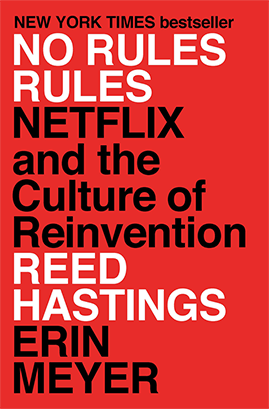 Publisher: Penguin Press
Publisher: Penguin Press
Publication Year: 2020
Number of Pages: 320
Imagine what it’d feel like to work for yourself..within a giant organization. With his behemoth, Netflix, CEO Reed Hastings has established a culture that comes about as close to this contradiction as it gets.
In No Rules Rules, Hastings advises leaders to “rip pages from the employee handbook” and build a culture that eliminates controls and demands candor from its employees. Netflix has no travel, vacation or expense policies. And there’s no approval policies, either.
How does he get away with keeping his employees on such a long leash…or no leash at all, really? His formula for building culture is a stack of three nesting dolls. First and foremost, Hastings says, building the right culture is about hiring talent. Next, you amp up candor, and finally you remove controls.
“If you build an organization made up of high performers, you can eliminate most controls. The denser the talent, the greater the freedom you can offer.”
“At Netflix, it is tantamount to being disloyal to the company if you fail to speak up when you disagree with a colleague or have feedback that could be helpful. After all, you could help the business—but you are choosing not to.”
Some mantras from its “culture slide deck” might raise eyebrows, such as: “Adequate performance gets a generous severance package.”
Yet given their success, it’s hard to challenge Netflix’s way of doing things. When Netflix went public twenty years ago, shares sold for $15. They now sell for a whopping $249. It consistently puts out wildly popular shows such as Ozarks and Stranger Things. More significantly, the company has built a culture that navigates dramatic change. While many businesses in the movie industry crashed and burned over the past twenty years, Netflix quickly adapted with the rapid pace of technology.
It’s certainly not too rash for any leader to take some cues from Hastings’ mantras. No Rules Rules speaks directly to leaders, and methodically explains how to establish a culture where people feel free to share, collaborate and learn from each other. Each chapter ends with key takeaways.
Co-author Meyer is a former Peace Corp. volunteer, professor and author of The Culture Map. She and Hastings alternately write the book, and their sketched image shows up in the margins when they hand off the baton.
Together, they smoothly guide the reader along the fantastic ride Netflix has had since its inception over twenty years ago.
The book starts with an anecdote of Blockbuster CEO John Antioco laughing in Hasting’s and Marc Randolph’s faces when they offer to sell Netflix to him for $50 million. Fast forward ten years and the DVD business model is archaic, Blockbuster is bankrupt, and Netflix is producing movies that receive Academy Awards.
“We had one thing that Blockbuster did not: a culture that valued people over process, emphasized innovation over efficiency, and had very few controls.”
At 320 pages, it’s more than a day’s read, but No Rules Rules is full of these fun sort of anecdotes that make it a page turner.
Although some have wondered if it’s too soon for Netflix to be tooting its own horn, most everyone enjoys a good David-slaying-Goliath story. And any leader looking to improve her workplace culture will find some nuggets in this book worth secreting away.
Take Back Your Power: 10 New Rules for Women at Work by Deborah Liu, with a forward by Sheryl Sandberg
 Publisher: HarperCollins
Publisher: HarperCollins
Publication Year: 2022
Number of Pages: 240
Have you ever been overlooked for a promotion…again and again? Or have you had someone else take the credit for your work contributions?
In Take Back Your Power, author Deborah Liu explains how a woman can thrive within a workplace culture that systematically marginalizes her.
“I wrote this book for anyone who is told that power is a dirty word, that it’s best to leave the leading and climbing to the guys….this book is a guide to changing yourself while changing the world.”
Sometimes it’s deeply ingrained patterns in women’s thinking that hold them back and keep them from competing against men in the workplace, Liu asserts. In the book, she retells anecdotes of her childhood, relating her insecurities growing up in a family of all girls within a culture that valued men, as well as stories of herself and female coworkers selling themselves short and being sidelined in business conversations.
Liu started the wildly popular Facebook Marketplace while working as a product manager at Facebook. Former Facebook COO Sheryl Sandberg, who wrote a forward to this book, interviewed and hired Liu to work at the company.
Liu has also supported professional women by starting a community for product managers in the Bay Area. And this isn’t her first foray into writing; she’s been writing the newsletter “Perspectives” on Substack for over a year now.
She’s broken Take Back Your Power into 10 “Rules,” including: “Know Your Playing Field,” “Don’t Give Yourself a Free Pass,” “Chart Your Own Course” and “Create Balance at Home.”
In that it’s part memoir, part manual, Take Back Your Power hearkens back to Sophia Amoruso’s 2014 book, #GirlBoss.
So far, readers have really taken to this book and its relatable anecdotes and practical skills for navigating systemic problems in workplace cultures.
Why Employees Are Always a Bad Idea (and Other Business Diseases of the Industrial Age) by Chuck Blakeman
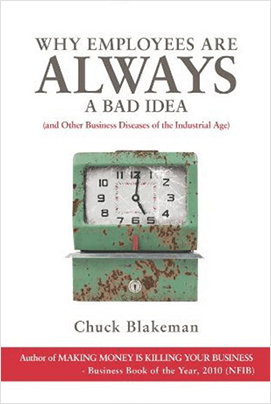 Publisher: Crankset Publishing, LLC
Publisher: Crankset Publishing, LLC
Publication Year: 2014
Number of Pages: 245
This book is for anyone whose job makes them feel like a cog in a wheel.
Author Chuck Blakeman writes that we’re well past the Industrial Age, where workers were “taught to act at work just like children; to shut up, don’t make waves and go out quietly.”
And we’ve evolved into the Participation Age, the hallmark of which is sharing. Examples of this include the rideshare company Uber, the home share company Airbnb, and the open source operating system Linux, which anyone around the world can view and edit.
People are no longer willing to work just for a paycheck, or to take orders from their boss. Rather, we want to be a part of things. Yet we’re still caught in the trappings of a bygone era.
Engaging the workforce today entails building a culture where employees are treated like comrades, and work provides meaning. Evolving from the Industrial Age even gets down to altering the language we use around the workplace. Phrases such as “personal time” and “vacation time” imply that an employer gives employees license on how he or she uses her time.
Blakeman is an international businessman and has owned several businesses. The book includes anecdotes about living and working abroad.
In the first part of the book, he outlines all the “diseases” of the Industrial Generation. Some of these include “Separation of Work and Play,” “9 to 5 Disease,” “Why Managers Are a Bad Idea” and the book’s title, “Why Employees Are Always a Bad Idea.”
Rather than employees, this Participation Age calls for stakeholders. People don’t want to work for someone anymore, they want to work with someone, in a company they’re part of.
In chapters such as, “How to Hire People You’ll Never Have to Manage,” this book includes guidance on how to build a culture within this Participation Age. With its case studies and action steps, it serves as an excellent guide for anyone looking to retain and motivate their employees.
Work Rules!: Insights from Inside Google That Will Transform How You Live and Lead by Laszlo Bock
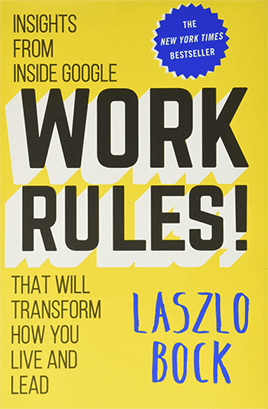 Publisher: Hachette Book Group
Publisher: Hachette Book Group
Publication Year: 2015
Number of Pages: 416
From the stories we’ve all heard, Google’s workplace culture sounds truly surreal. People bring their dogs to work (but not their cats!), do their laundry and climb indoor rock walls in the afternoons. It’s almost as though at Google, every day is Saturday. But is this really the case?
In Work Rules!, former Google Executive Laszlo Bock offers a peek behind the curtains at the culture in this Silicon Valley legend. He makes no denial that Google is a lot of fun. But “you can be serious without a suit,” he adds. The fun really fosters innovation.
Google places a huge emphasis on hiring, using a method that looks at data over intuition. After it’s recruited the best, the company treats employees well. For example, every employee at Google receives stock in the company.
“They (Larry and Sergey) wanted to create a company where work was meaningful, employees felt free to pursue their passions, and people and their families were cared for.”
Bock’s book isn’t just for business leaders: it’s for you and me. Regardless of who you are or where you work, Bock believes that building a culture is all about a frame of mind.
“It is within anyone’s grasp to be the founder and culture-creator of their own team, whether you are the first employee or joining a company that has existed for decades.”
Laszlo began his scrappy career cold-calling human resource executives at major companies. Only General Electric got back to him, and it resulted in his first job in human resources. Things only progressed from there. As the Senior Vice President of People Operations at Google, he became a human resources legend of sorts, earning all sorts of awards and recognition for making Google a great place to work. Now he runs his own company, Humu.
The “punny” title (and one which Hastings undoubtedly ripped off) hints at his style. It’s a fun book, though a bit all over the place. In addition to stories from Google and his own life, within just the first few pages he’s also telling us about Oprah, Henry Ford, the Hershey Company and the mythical characters Romulus and Remus.
Chapter titles range from the playful, to the shocking, to the practical: “Lake Wobegon Where All the New Hires Are Above Average: Why hiring is the single most important people activity in any organization” (he’s dating himself here with Keillor reference!), “Pay Unfairly: Why it’s okay to pay two people in the same job completely different amounts” and “What You Can Do Starting Tomorrow: Ten steps to transform your team and your workplace.”
But he’s definitely serious about providing takeaways for the reader. Each chapter ends with a list of action steps alongside checkboxes to tick once they’re completed.
Laszlo strongly believes that as a former google HR executive, he can teach you something. –And just as strongly that whoever you are, you can take what you learn and contribute: to you team, to your employees, to your volunteer book group. Building culture is within anyone’s grasp, and it’s all about a frame of mind.
Although many read this book as a “tell all/memoir” on the inner workings of Google, if you’re looking for tips and inspiration to build communities in your life, there’s plenty of takeaways for that as well.
I Love It Here by Clint Pulver
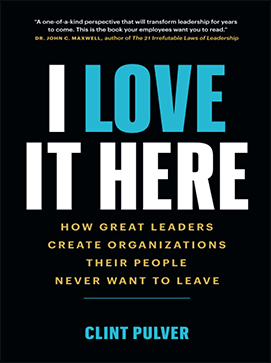 Publisher: Page Two
Publisher: Page Two
Publication Year: 2021
Number of Pages: 209
Remember that movie Office Space, where nobody could stand the boss, and he wasn’t even aware of it? According to Clint Pulver, this sort of thing doesn’t just happen in the movies.
“There is a major gap between what an employer perceives and what an employee expects,” Pulver writes in I Love It Here.
As the self-titled Undercover Millennial (a title he’s trademarked), Pulver boasts of having interviewed over ten thousand employees in order to understand what makes them remain at a job and what makes them run for the hills the minute they see a way out.
If you want to build a team that genuinely loves working for you, this book provides some guidelines. Pulver outlines failed methods for creating an open environment (the employee survey, the 1:1 meeting with the manager) and solutions that really work, such as managers who serve as mentors, and employees who are given autonomy over their position and job duties.
Pulver founded the Center for Employee Retention, and has advised AT&T and Hewlett Packard. He’s also a keynote speaker, and gives workshops in developing collaborative workplace cultures.
He wrote this book in first person, and it includes many colorful anecdotes. At just over 200 pages, you can breeze through it in a long afternoon.
The Fearless Organization: Creating Psychological Safety in the Workplace for Learning, Innovation, and Growth by Amy C. Edmondson
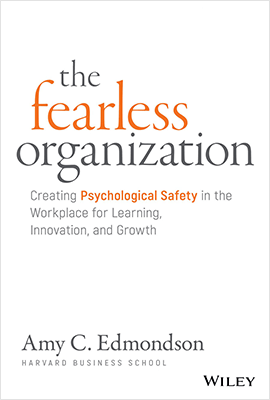 Publisher: John Wiley & Sons, Inc.
Publisher: John Wiley & Sons, Inc.
Publication Year: 2018
Number of Pages: 256
Does company culture really make the difference between a satisfied customer who gives a five star online review, and an irate customer who blasts you and your product all over social media? Dr. Amy Edmondson believes so.
Edmondson believes that in today’s economy, brains are the real machinery behind any industry. Yet building this machinery is not so simple as hiring talent. It takes the right environment to unleash this brainpower. Psychological safety makes all the difference between a functioning and nonfunctioning workplace.
What is psychological safety? It has to do with minimizing interpersonal fear.
“In psychologically safe workplaces, people know they might fail, they might receive performance feedback that says they’re not meeting expectations, and they might lose their jobs…but in a psychologically safe workplace, people are not hindered by interpersonal fear. They feel willing and able to take the inherent interpersonal risks of candor.”
A work environment where people don’t feel safe sharing opinions and expertise yields scenarios where patients are misdiagnosed, customer’s needs aren’t met and money is left on the table.
The book is written in a dry, academic style, which makes sense as Edmondson is a Harvard Professor. She’s researched the topic rather than discovered the knowledge first-hand. It includes many case studies on psychological safety.
Perhaps the book is a bit too wordy. But readers find it’s not full of fluff. It includes substantive anecdotes and concrete takeaways for building a company culture free of fear.
5 Languages of Appreciation in the Workplace by Gary D. Chapman & Paul E. White
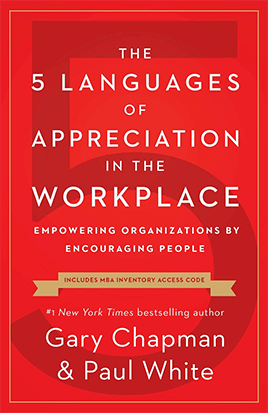 Publisher: Northfield Publishing
Publisher: Northfield Publishing
Publication Year: 2012
Number of Pages: 256
“If my boss lifted one finger to help me, I’d die from a heart attack,” said pretty much everyone of at least one of their employers over the years.
In 5 Languages of Appreciation, authors Chapman and White assert that appreciation is critical to building a culture of dedicated employees. Everyone wants to believe their work matters.
Appreciation is so fundamental that an employee who feels unappreciated generally looks for another job: even if everything else about the position is great, including benefits and pay. Conversely, if someone feels appreciated at their job, he couldn’t be swayed to leave it for any amount of money.
This book is designed for business leaders, and teaches them how to meaningfully communicate appreciation to individual employees.
Appreciation is more than just saying “thanks.” Chapman and White find that people communicate and receive appreciation differently based on their personalities. They’ve broken appreciation down into five “languages” with a chapter dedicated to each one: Words of Affirmation, Quality Time, Acts of Service, Tangible Gifts and Physical Touch.
The same duo also wrote the New York Times Bestseller, The Five Love Languages: The Secret to Love that Lasts.
Appreciation is the cornerstone to any healthy company culture. And with this book, incorporating methods and practices of appreciation are well within anyone’s reach.
Conclusion
And there you have it. The experts, as you can see, have indeed waxed poetic about company culture. Most of these books read like a cross between a memoir and a how-to novel. And there’s lot of good stories in each of them.
Even with the variety of perspectives, each author imparts a similar message: culture is critical. A healthy culture unleashes potential, and a toxic culture thwarts it.
Culture is expressed in the visible, but indicative of something that’s not seen: shared values and a common vision.
Sometimes building a strong culture is as easy as consistently taking a few moments to thank someone else with the gift of time. At other times, it entails overhauling systems and pushing through red tape. Oftentimes, it’s about learning from what hasn’t worked in the past.
But it’s always possible to build culture. And all the takeaways and checklists in these books put you in the driver’s seat to build your own. What’s a practical step you’re taking to build a strong culture in your workplace or community?

